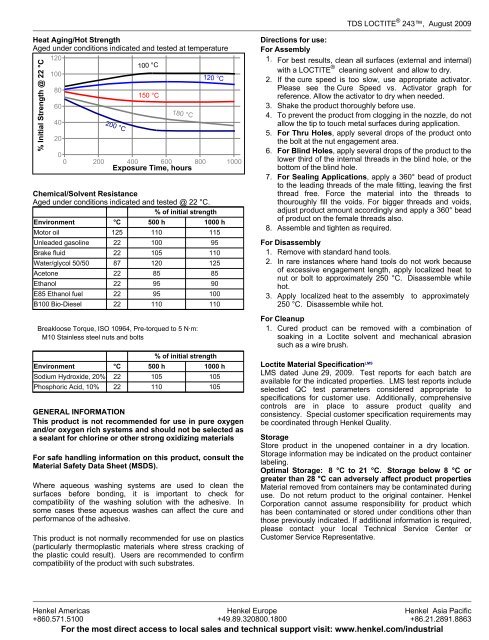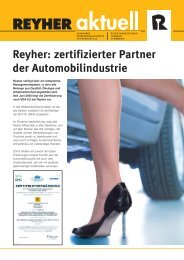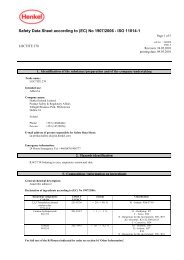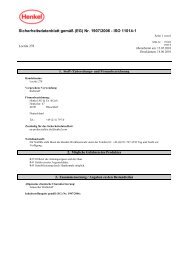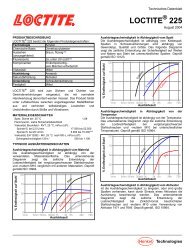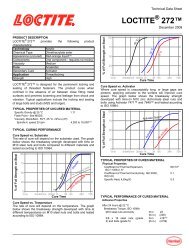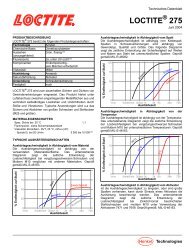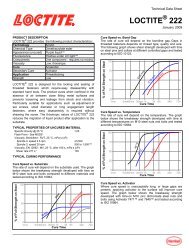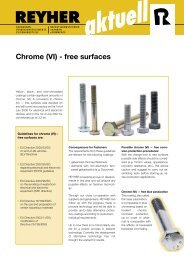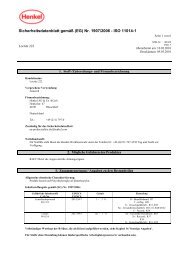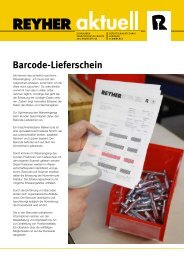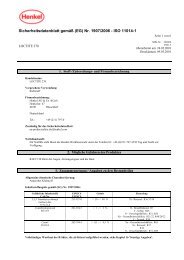Technical data sheet Loctite ® 243 - REYHER
Technical data sheet Loctite ® 243 - REYHER
Technical data sheet Loctite ® 243 - REYHER
Create successful ePaper yourself
Turn your PDF publications into a flip-book with our unique Google optimized e-Paper software.
TDS LOCTITE ® <strong>243</strong>, August-2009<br />
Heat Aging/Hot Strength<br />
Aged under conditions indicated and tested at temperature<br />
120<br />
% Initial Strength @ 22 °C<br />
100<br />
80<br />
60<br />
40<br />
20<br />
200 °C<br />
100 °C<br />
150 °C<br />
180 °C<br />
0<br />
0 200 400 600 800 1000<br />
Exposure Time, hours<br />
120 °C<br />
Chemical/Solvent Resistance<br />
Aged under conditions indicated and tested @ 22 °C.<br />
% of initial strength<br />
Environment °C 500 h 1000 h<br />
Motor oil 125 110 115<br />
Unleaded gasoline 22 100 95<br />
Brake fluid 22 105 110<br />
Water/glycol 50/50 87 120 125<br />
Acetone 22 85 85<br />
Ethanol 22 95 90<br />
E85 Ethanol fuel 22 95 100<br />
B100 Bio-Diesel 22 110 110<br />
Breakloose Torque, ISO 10964, Pre-torqued to 5 N·m:<br />
M10 Stainless steel nuts and bolts<br />
% of initial strength<br />
Environment °C 500 h 1000 h<br />
Sodium Hydroxide, 20% 22 105 105<br />
Phosphoric Acid, 10% 22 110 105<br />
GENERAL INFORMATION<br />
This product is not recommended for use in pure oxygen<br />
and/or oxygen rich systems and should not be selected as<br />
a sealant for chlorine or other strong oxidizing materials<br />
For safe handling information on this product, consult the<br />
Material Safety Data Sheet (MSDS).<br />
Where aqueous washing systems are used to clean the<br />
surfaces before bonding, it is important to check for<br />
compatibility of the washing solution with the adhesive. In<br />
some cases these aqueous washes can affect the cure and<br />
performance of the adhesive.<br />
This product is not normally recommended for use on plastics<br />
(particularly thermoplastic materials where stress cracking of<br />
the plastic could result). Users are recommended to confirm<br />
compatibility of the product with such substrates.<br />
Directions for use:<br />
For Assembly<br />
1. For best results, clean all surfaces (external and internal)<br />
with a LOCTITE ® cleaning solvent and allow to dry.<br />
2. If the cure speed is too slow, use appropriate activator.<br />
Please see the Cure Speed vs. Activator graph for<br />
reference. Allow the activator to dry when needed.<br />
3. Shake the product thoroughly before use.<br />
4. To prevent the product from clogging in the nozzle, do not<br />
allow the tip to touch metal surfaces during application.<br />
5. For Thru Holes, apply several drops of the product onto<br />
the bolt at the nut engagement area.<br />
6. For Blind Holes, apply several drops of the product to the<br />
lower third of the internal threads in the blind hole, or the<br />
bottom of the blind hole.<br />
7. For Sealing Applications, apply a 360° bead of product<br />
to the leading threads of the male fitting, leaving the first<br />
thread free. Force the material into the threads to<br />
thouroughly fill the voids. For bigger threads and voids,<br />
adjust product amount accordingly and apply a 360° bead<br />
of product on the female threads also.<br />
8. Assemble and tighten as required.<br />
For Disassembly<br />
1. Remove with standard hand tools.<br />
2. In rare instances where hand tools do not work because<br />
of excessive engagement length, apply localized heat to<br />
nut or bolt to approximately 250 °C. Disassemble while<br />
hot.<br />
3. Apply localized heat to the assembly to approximately<br />
250 °C. Disassemble while hot.<br />
For Cleanup<br />
1. Cured product can be removed with a combination of<br />
soaking in a <strong>Loctite</strong> solvent and mechanical abrasion<br />
such as a wire brush.<br />
<strong>Loctite</strong> Material Specification LMS<br />
LMS dated June-29, 2009. Test reports for each batch are<br />
available for the indicated properties. LMS test reports include<br />
selected QC test parameters considered appropriate to<br />
specifications for customer use. Additionally, comprehensive<br />
controls are in place to assure product quality and<br />
consistency. Special customer specification requirements may<br />
be coordinated through Henkel Quality.<br />
Storage<br />
Store product in the unopened container in a dry location.<br />
Storage information may be indicated on the product container<br />
labeling.<br />
Optimal Storage: 8 °C to 21 °C. Storage below 8 °C or<br />
greater than 28 °C can adversely affect product properties<br />
Material removed from containers may be contaminated during<br />
use. Do not return product to the original container. Henkel<br />
Corporation cannot assume responsibility for product which<br />
has been contaminated or stored under conditions other than<br />
those previously indicated. If additional information is required,<br />
please contact your local <strong>Technical</strong> Service Center or<br />
Customer Service Representative.<br />
Henkel Americas<br />
+860.571.5100<br />
Henkel Europe<br />
+49.89.320800.1800<br />
Henkel Asia Pacific<br />
+86.21.2891.8863<br />
For the most direct access to local sales and technical support visit: www.henkel.com/industrial


